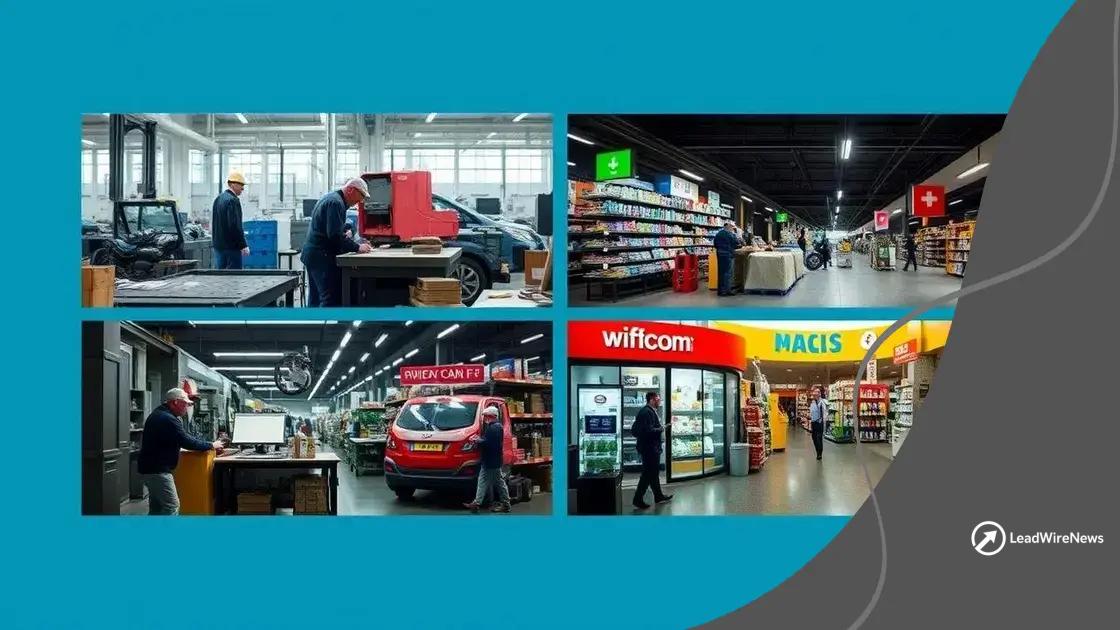Economic slowdown risks mid-2025: what to expect

Anúncios
The economic slowdown risks mid-2025 are driven by rising inflation, changing consumer behavior prioritizing essentials, and the need for businesses to adopt agile strategies to navigate uncertainty effectively.
Economic slowdown risks mid-2025 are on the horizon, and it’s time to ask: how prepared are we? With market fluctuations and uncertainties looming, understanding these risks could be crucial for both consumers and businesses.
Anúncios
Understanding the current economic climate
The current economic climate is a complex web of factors that influences everything from job markets to investment opportunities. Understanding this landscape is crucial for businesses and consumers alike. In this section, we will explore some of the key elements that shape today’s economic conditions.
Key Factors Influencing Economic Climate
Several factors play a significant role in the health of our economy. Here are some of the most impactful:
- Inflation rates: When prices rise, purchasing power decreases, affecting consumer spending.
- Government policies: Tax changes and regulations can either stimulate or slow down economic growth.
- Global events: Issues like pandemics or geopolitical tensions can disrupt international trade and supply chains.
- Consumer confidence: When people feel secure in their jobs, they are more likely to spend, which fuels the economy.
Another critical aspect to consider is how these factors interconnect. For instance, rising inflation can lead to decreased consumer spending. In turn, this can affect businesses, leading to layoffs or hiring freezes. Furthermore, the impact of global events, such as the recent pandemic, showed how quickly and deeply economic conditions can shift.
Anúncios
This ongoing relationship means that businesses must keep a close eye on these indicators. Monitoring economic reports and trends can provide valuable insights into future changes. As we delve deeper, we will also look at what specific sectors might bear the brunt of any shifts in the economy.
Effective navigation of the current economic climate requires strategy and preparedness. By understanding the interplay of various factors, businesses can position themselves to adapt more swiftly to changes that may arise in the coming years.
Factors contributing to the slowdown
The factors contributing to the slowdown in the economy are interrelated and complex. Each of these factors can amplify the effects of the others, leading to a significant economic impact. Understanding them is crucial for businesses and consumers to navigate this challenging landscape.
Monetary Policies
Monetary policies set by central banks can greatly influence the economy. When interest rates rise, borrowing becomes more expensive. This can lead to a decrease in consumer spending and business investments.
- Higher interest rates: Loans for homes, cars, and businesses become costlier.
- Reduced investments: Businesses may delay or scale back projects due to increased borrowing costs.
- Stronger currency: A high currency value can hurt exports, as products become more expensive for foreign buyers.
In addition to monetary policies, global disruptions also play a critical role. For example, natural disasters or geopolitical issues can affect supply chains. A disruption in one part of the world can lead to shortages and increased costs elsewhere.
Consumer Behavior Trends
Consumer behavior is another vital factor. When people are uncertain about the economy, they tend to save money instead of spending it. This shift can reduce demand for goods and services, leading to slower economic growth.
- Increased savings rates: People may choose to save more, dampening spending.
- Shift in priorities: Consumers may focus on essential goods over luxury items.
- Changing confidence: Economic uncertainty often leads to hesitance in spending among consumers.
All these aspects contribute to a potential economic slowdown. It is essential for stakeholders to monitor these factors closely. By staying informed about these influences, businesses can better prepare for future challenges.
Sector-specific impacts of the downturn

The sector-specific impacts of the downturn can vary greatly depending on the industry in question. Different sectors respond uniquely to economic changes due to their operational structures, consumer bases, and market demands. Understanding these impacts is essential for businesses and investors alike.
Retail Sector Challenges
In the retail sector, consumers often tighten their belts during economic downturns. This shift leads to decreased spending, affecting sales significantly.
- Decline in discretionary spending: Customers prioritize essential goods over luxury items.
- Increased competition: Stores may offer more discounts to attract limited spending.
- Shift to online shopping: Economic pressures can accelerate the trend toward e-commerce.
The retail landscape becomes increasingly competitive as businesses attempt to make sales amid reduced consumer budgets. This environment can lead to closures of weaker brick-and-mortar stores while stronger brands adapt by enhancing their online presence.
Manufacturing Sector Effects
The manufacturing sector also faces distinct challenges during an economic downturn. Production may slow due to reduced demand for goods.
- Lower demand for non-essential goods: Factories may cut back on shifts or production lines.
- Job losses: Layoffs become common as companies seek to reduce costs.
- Supply chain disruptions: Manufacturers rely on consistent supply; economic pressures can interrupt this flow.
These factors create a ripple effect throughout the economy, impacting suppliers, transportation, and logistics. As manufacturers adjust their operations, they may invest in technology or processes that help maintain efficiency despite lower demand.
Understanding how each sector responds to economic challenges can guide decision-makers in strategizing for recovery. By analyzing specific impacts, businesses can better adjust their operations and prepare for a post-downturn environment.
Strategies for businesses to navigate uncertainty
In times of uncertainty, strategies for businesses to navigate uncertainty are crucial for survival and growth. By implementing effective plans, companies can adapt to fluctuating conditions and maintain their competitive edge.
Emphasizing Agility
Agility is key for businesses during unpredictable times. Companies should be ready to pivot quickly in response to market changes.
- Flexible operations: Reducing overhead costs can allow businesses to adapt to revenue fluctuations.
- Real-time data analysis: Utilizing analytics tools helps companies understand market trends quickly.
- Employee training: Regular training ensures that employees can handle various roles, increasing flexibility.
Incorporating an agile approach enables companies to respond to changes without significant delays. This proactive strategy can help businesses stay ahead of their competitors.
Diversifying Offerings
Diversification can mitigate risks associated with market uncertainty. Offering a wider range of products or services can attract different customer segments.
- New revenue streams: Businesses can explore additional markets or customer bases.
- Partnerships: Collaborating with other companies can lead to unique service offerings and shared resources.
- Innovation: Encouraging a culture of innovation can lead to the development of new products that meet changing consumer needs.
Through diversification, companies can cushion themselves against downturns in specific areas, making them less vulnerable to drastic declines.
Maintaining robust communication with customers is also essential. Keeping clients informed can build trust, especially during difficult times. Regular updates about changes in service or product availability can enhance customer loyalty.
Ultimately, using a combination of agility, diversification, and effective communication can empower businesses to navigate the murky waters of uncertainty successfully.
Consumer behavior changes during economic challenges
During times of economic challenges, consumer behavior changes significantly. Understanding these shifts can help businesses adapt their strategies to meet evolving demands.
Prioritization of Essentials
One major change is the shift in spending priorities. When economic uncertainty looms, consumers tend to prioritize essential items over luxury goods.
- Increased focus on basic needs: Groceries and healthcare become top spending categories.
- Decreased discretionary spending: Consumers cut back on dining out, entertainment, and luxury purchases.
- Comparison shopping: Shoppers are more likely to seek out deals and discounts, leading to increased competition among retailers.
These behaviors reflect a more cautious approach to spending, as individuals try to conserve resources during uncertain times.
Shift to Online Shopping
Another trend during economic downturns is the acceleration of online shopping. Many consumers turn to e-commerce platforms for convenience and competitive pricing.
- Preference for ease: Shopping from home saves time and money on travel.
- Broad selection: Online platforms often provide a wider array of products compared to physical stores.
- Price transparency: Consumers appreciate the ability to compare prices quickly online.
This shift has changed the landscape for many retailers, emphasizing the need for a strong online presence.
Additionally, consumer sentiment during economic challenges can impact purchasing decisions. Many people become more skeptical and cautious, often waiting for signs of recovery before making large purchases.
Businesses must stay aware of these changing trends. By understanding how consumers adjust their behaviors during economic challenges, companies can develop tailored marketing strategies and responsive product offerings.
FAQ – Frequently Asked Questions about Economic Slowdown Risks
What are the main factors causing the economic slowdown?
Key factors include rising inflation rates, changes in government policies, and global events that disrupt supply chains.
How does consumer behavior change during economic challenges?
Consumers tend to prioritize essential goods, reduce discretionary spending, and increasingly turn to online shopping for better deals.
What strategies can businesses use to navigate uncertainty?
Businesses should focus on agility, diversify their offerings, and maintain clear communication with customers to adapt to changing conditions.
Why is understanding sector-specific impacts important?
Different sectors respond uniquely to economic conditions. Understanding these impacts helps businesses tailor strategies to stay competitive.